Procedures of Endotracheal Intubation
Procedures of Endotracheal Intubation
When assembling equipment for intubation, has the list of equipment as explained in the table 5.1 of equipment required during laryngoscope and intubation.
Positioning the Patient for Intubation
Positioning the patient is important to the success and ease of intubation (Figure 6.9). The neck should be slightly flexed and head extended (sniffing position) to allow for the best view of the larynx. In adults, one or two pillows or blankets should achieve this. In children, no pillow is needed. In infants it may be necessary to place a small pillow under the shoulders.

Steps of Intubation
The First Step in an anesthetic induction is to pre-oxygenate the patient with 100% oxygen (Figure 6.10). This will remove nitrogen from the lungs. Remember that the air we breathe contains only 21% oxygen. The induction of general anesthesia will abolish or diminish the patient's ability to spontaneously breathe. If difficulties are encountered with the establishment of a patent airway, then the patient has an enlarged reservoir of oxygen, increasing the margin of safety.Pre-oxygenation is accomplished with a mask held tightly against the patient's face. Pre-oxygenate the patient for 3-5 minutes. Alternatively, ask the patient to take 8-10 deep, vital capacity breaths. This should be completed prior to the anesthetic induction. Once general anesthesia is induced, mask ventilates the patient unless you are performing a rapid sequence induction.
Do not use excessive pressure when ventilating the patient with mask. Do not exceed 20 cmH2O otherwise you will introduce air into the stomach.
Mask ventilation may be difficult in patients with a full beard, patients without teeth, obese patients, and patients that have a decreased mobility of the neck. Be prepared! Have an alternate airway plan available to maintain a patent airway.
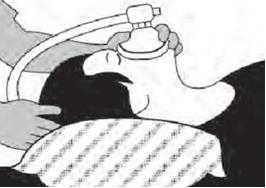
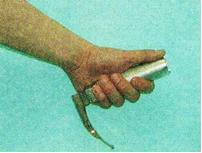
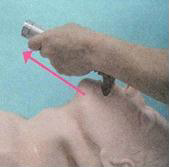
The Next Step Is to Take the Laryngoscope in the Left Hand (Figure 6.11). Place the blade gently into the right side of the patient's mouth (Figure 6.113). Advance the blade until the uvula is visualized. During this process the laryngoscope blade has to slide to the midline of the mouth, shifting the tongue to the left.
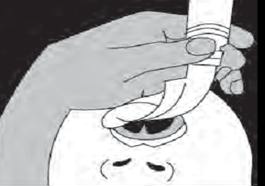

At this point the blade should be in the middle of the mouth. Gently advance the blade until the epiglottis comes into view (Figure 6.13). If we are using a curved blade the tip of the curved blade will go into the vallecula. When using a straight blade the anesthesia provider will pick up the epiglottis (Figure 6.14).
At this point check to make sure that the patient's lips and tongue are not caught between the laryngoscope blade and the teeth. Gently lift the laryngoscope upwards toward the ceiling.
Take care not to rock the laryngoscope back and forth. Make sure pressure is not applied to the patient's teeth. This will result in dental trauma.
If you are having trouble seeing the patient's anatomy, have an assistant retract the patient's right upper lip (Table 6.3). This may improve your view. At this point your assistant should hand you the endotracheal tube. Place the endotracheal tube through the vocal cords to midtrachea.
Immediately after intubation, the cuff is inflated, and the anesthetist should observe the sequential rise and fall of the chest while auscultating over each midaxillary line and the epigastrium to assure that the trachea, not the esophagus or bronchi, has been intubated.
Causes of Difficult Visualization During Laryngoscopy
- Improper positioning of the head
- Inadequate opening of the mouth
- Selecting the wrong blade
- Allowing the tongue to hang over the right side of the blade
- Applying and obscuring the line of vision with the endotracheal tube during its insertion.
- If the epiglottis is not seen
- The blade may have been inserted too far, providing a view of the esophagus. Slowly withdrawing the laryngoscope may let the epiglottis drop into view.
- Selecting too short a blade will prevent the tip from reaching the glossoepiglottic reflection.
Table 6.3 Maneuvers Used to Optimize the View at Direct Laryngoscopy
- Maximum head extension
- Tongue entirely to the left of the laryngoscope
- Optimal depth of insertion of the laryngoscope
- Strong lifting force applied in the correct direction to the laryngoscope
- External laryngeal manipulation-applied initially with the right hand of the anesthetist
Confirmation of Placement of the Tube
There are objective and subjective means of confirming ETT location. For every intubation, at least two objective criteria of ETT location should be met.
Objective Methods of Confirming Endotracheal Tube Location
Observing the ETT goes through the cords: If the ETT is visualized going between the cords, it must be in the correct place. A few additional comments on this otherwise simplistic statement are in order:
- This is such an important confirmatory sign that the ETT should be placed slowly and deliberately, allowing time to consciously confirm that the ETT is indeed visible between the cords. This is the reason the ETT should be inserted from the right side of the mouth to allow ongoing visualization of the cords during ETT placement.
- If intubation has been undertaken in the face of a poorly visualized glottic opening, applying downward (posterior) pressure on the ETT while continuing to apply an upward lift on the laryngoscope (the "Ford maneuver") may sometimes allow visualization of posterior elements of the larynx.
End-Tidal Carbon Dioxide (ETCO2)
- Colorimetric end-tidal CO2 detection: A disposable CO2 detector is simply placed in-line at the ETT connector (in the patient with a cardiac output). The presence of exhaled CO2 will be indicated by a change in color, for example, from purple to yellow (Figure 6.15).
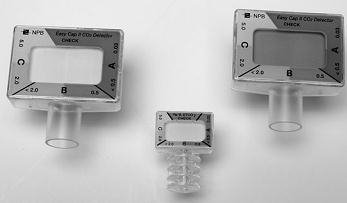
- Capnographs: The presence of carbon dioxide in the exhaled gases from the endotracheal tube as detected by capnograph (end-tidal PCO2 > 30 mm Hg for three to five consecutive breaths) should be immediate and sustained. Carbon dioxide may initially be present in low concentrations, but will not persist in exhaled gases from a tube accidentally placed in the esophagus.
- Esophageal Detector Devices: The principle behind esophageal detector device (EDD) use is that the esophagus collapses when a negative pressure is applied to its lumen, whereas the trachea does not. EDDs come in two forms:
A 60 cc catheter-tipped (Toomey) syringe can be used (Figure 6.16). Normally used for aspirating or irrigating foley catheters or nasogastric tubes, the tip of such a syringe can be forced into the end of the ETT connector after intubation. The syringe plunger is aspirated and released. If the plunger stays out, there is no negative pressure, implying it has aspirated air out of the tracheal air-space and the tube is correctly sited. If the plunger slides back to near its original position, the ETT is in the esophagus.
| Figure 6.15 EDD with 60 cc syringe | Figure 6.16 EDD with rubber bulb |
|---|---|
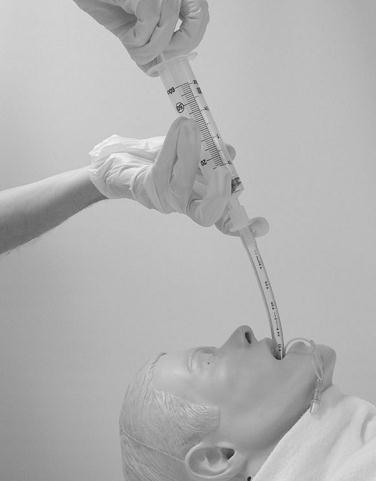 |
 |
A second type of EDD uses a rubber bulb (Figure 6.17) proximally on a syringe, which returns to inflated conformation spontaneously after being squeezed. The bulb is squeezed and the device attached to the ETT. If it refills quickly (with air from the tracheal airspace), the ETT is in the trachea. If it stays depressed or refills slowly, the ETT is in the esophagus.
Subjective (Clinical) Signs of Tracheal Intubation
- Chest Auscultation: Symmetrical bilateral movement of the chest with manual ventilation, combined with the presence of bilateral breath sounds on apical or midaxillary auscultation of the lungs is confirmed after tracheal intubation.
- Increasing oxygen saturation but in a well preoxygenated patient, oxygen desaturation following apnea can take up to 8 minutes.
- A characteristic feel of the reservoir bag, associated with normal lung compliance during manual inflation of the lungs and the presence of expiratory refilling of the bag, is evaluated.
- Vapor or misting on the inside of the ETT on expiration but this is not a reliable sign of tracheal intubation, as ETT misting can also occur with esophageal tube placement.
- The patient can no longer speak
- Auscultation over the stomach: If sounds are heard coincident with delivery of positive pressure ventilation on auscultation of the epigastrium, esophageal intubation should be suspected.
- Heart rate and BP normalize. A hypoxic patient may become hyper- or hypotensive and initially tachycardia. Bradycardia occurs as a later sign of profound hypoxia in adults, although earlier in children. Such continued worsening of vital signs suggests an esophageal intubation
Securing the Endotracheal Tube
Following confirmation of appropriate endotracheal tube (ETT) positioning, the tube must be secured to the patient. Fixing tube will help to prevent accidental dislodgement or advance of the tube. This can be done by taping the endotracheal tube at the patient's lips (face) corresponding to the 21- to 23-cm (adult) markings on the tracheal tube usually places the distal end of the endotracheal tube in the midtrachea. Perspiration, blood, vomitus, and other body liquids may interfere with tape adherence. Water proof tape is preferred to ensure tape adherence. An oropharyngeal airway or roll of gauze sponges placed between the teeth keeps the patient from biting ETT.